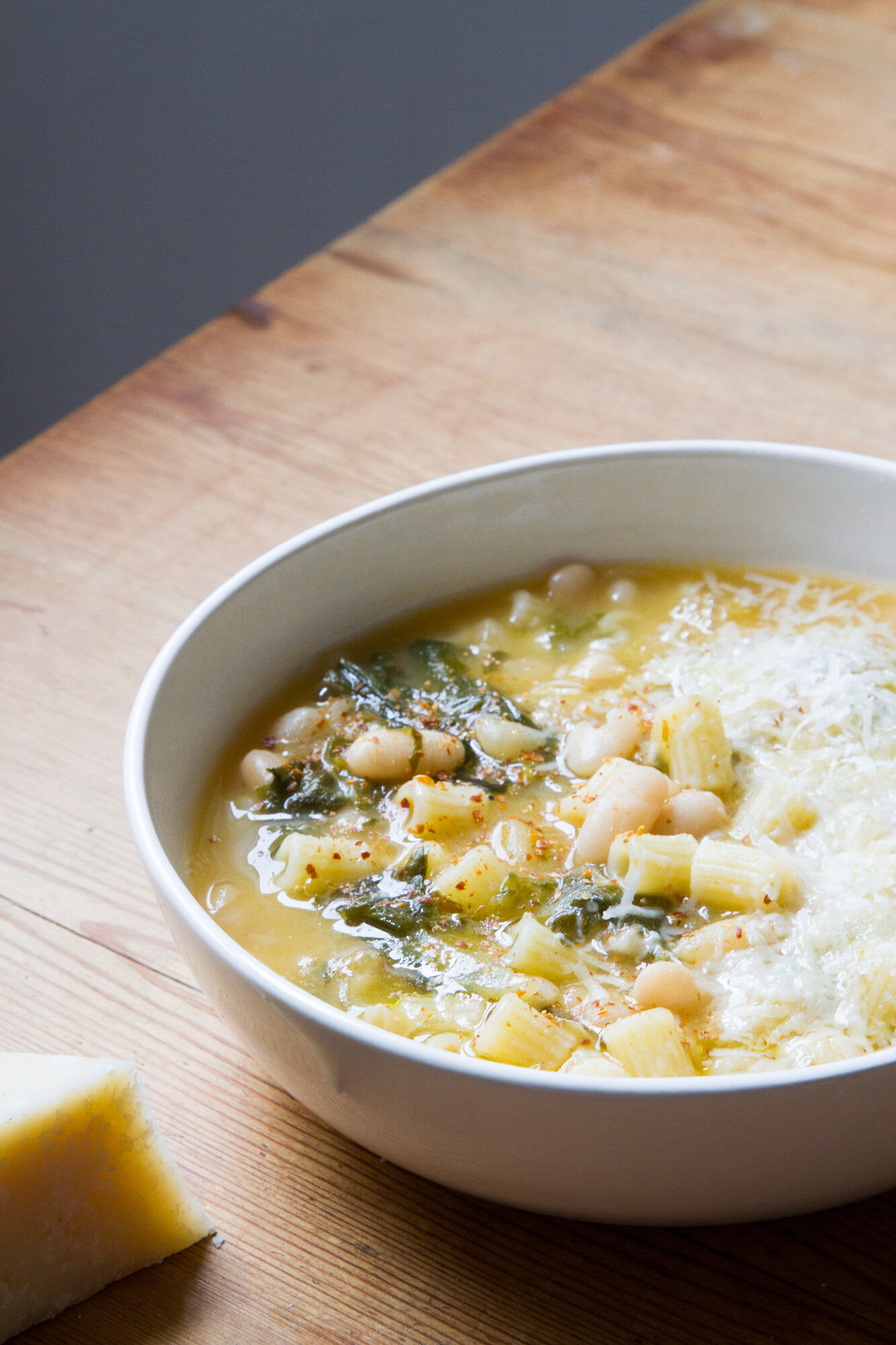 Waste Not is a collaboration with my friend, Carrie King. The premise is simple: Carrie, a food writer and editor, shares a vegetarian recipe highlighting at least one particular way that we can curb food waste. I make it at home, take a bunch of pictures, and share it with everyone here.
Waste Not is a collaboration with my friend, Carrie King. The premise is simple: Carrie, a food writer and editor, shares a vegetarian recipe highlighting at least one particular way that we can curb food waste. I make it at home, take a bunch of pictures, and share it with everyone here.
This week I made Carrie’s White Bean and Escarole Soup, which makes very smart use of Parmigiano rinds for extra flavor. This soup is extremely delicious. With just a little bit of time, it develops into something creamy and rich, but decidedly not heavy. It’s the perfect soup for enjoying while riding out an early spring snow storm. (Spoken from experience.)
From Carrie:
I once heard that every time someone composts a Parm rind, an angel loses its wings.
Maybe not, but definitely each time a rind thuds against a trash can, some Parmigiano maker in Italy disappears a little, kind of like Michael J Fox in Back-to-the-Future when he is, er… dating his mom.
Ok, fine. When you toss a perfectly good Parm rind, probably nothing really happens other than you waste a seriously valuable food treasure. But… isn’t that bad enough?
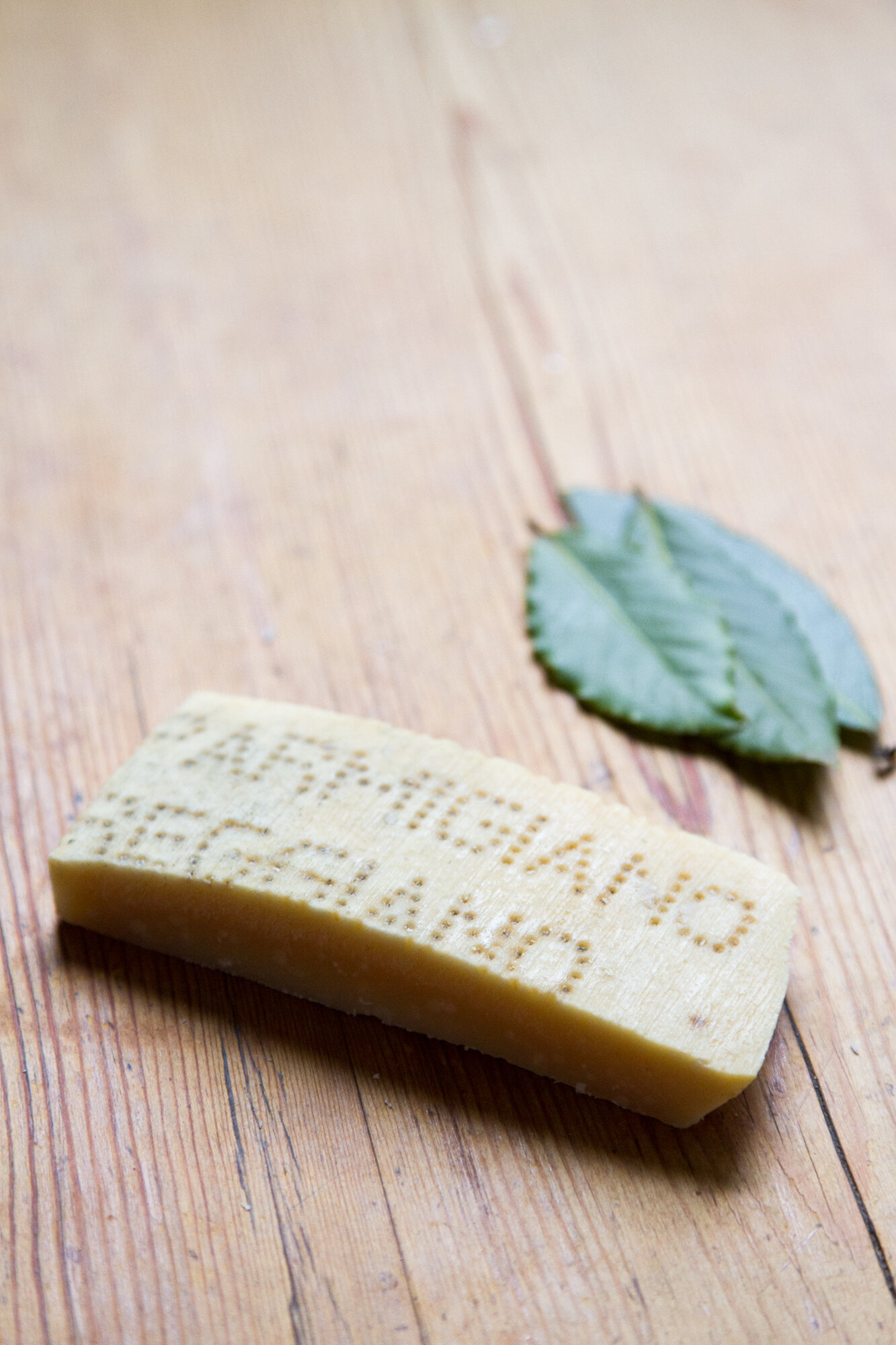
Aside from the fact that Parmigiano-Reggiano is the undisputed mostly-agreed-upon King of Cheeses, it’s also kind of a splurge. It’s not like they’re giving it away—a good deal on the real stuff is likely to set you back $19 or $20/lb. Bear with me for some simple math: If you paid $10 for your last hunk of cheese, and the weighty rind accounts for 20% of the price, and you throw it out, you’re depositing almost $2 in the trash. And $2 isn’t a fortune, but multiply that $2 times all the Parm you buy in your life and suddenly it’s like, you could have flown to Italy and back with the money you discarded. Not to mention, I just spied my local Whole Foods selling pint containers of rinds for $8.99/lb! I don’t think they could get away with that if Parm rinds were worthless! 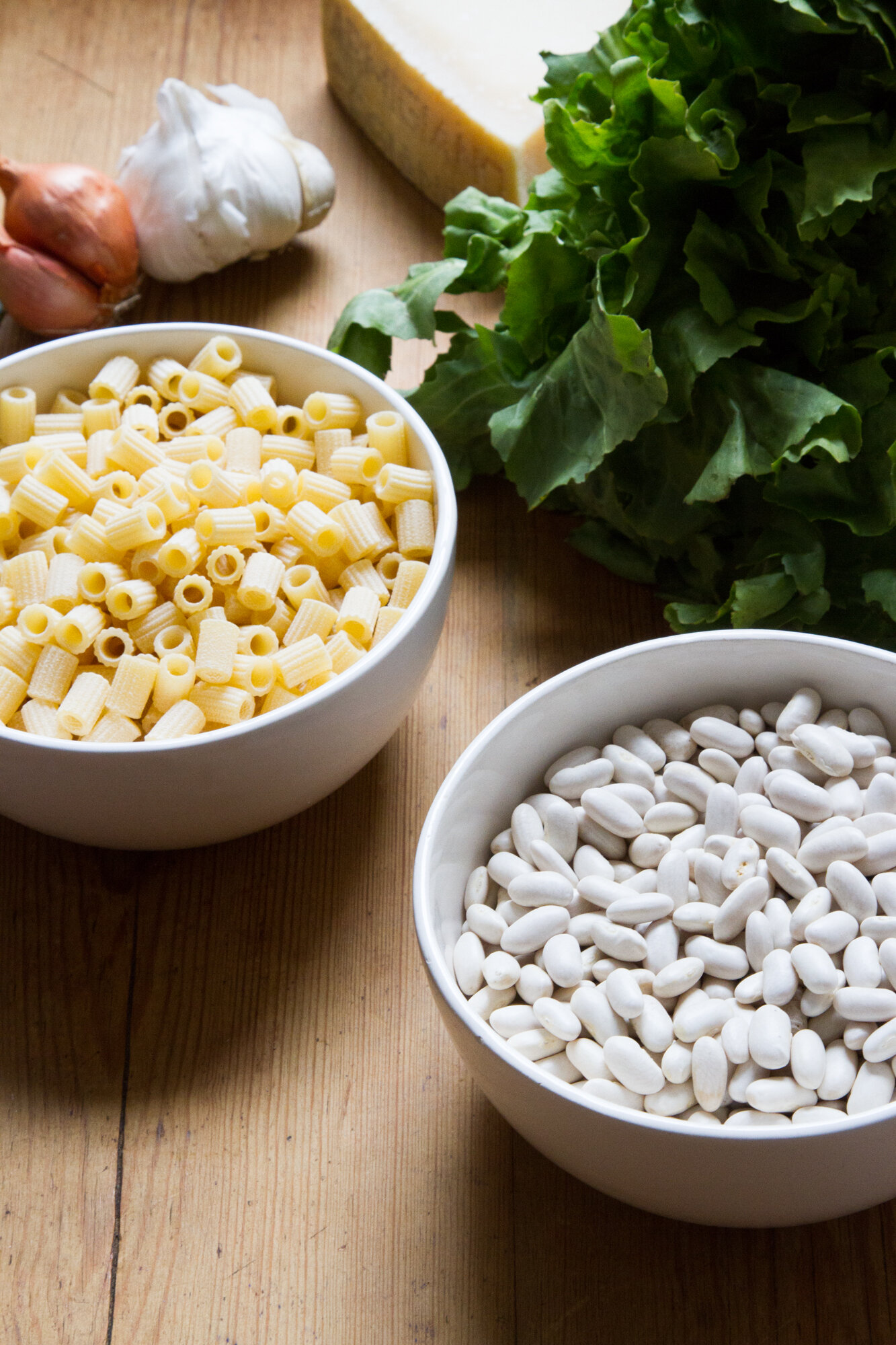
Beyond the fact that it’s not cost-effective to toss it, I think there’s a popular misconception that maybe cheese rinds aren’t edible? Some of them definitely aren’t, ie those made of cloth or hard red wax. Definitely don’t throw them in a soup unless you love red broth. But, most other rinds are good-to-go! Just think of them as the hardened, roughed up version of the actual cheese itself. Yes, some of them are stinky. And, sometimes they’re moldy. Or not that pleasing to the eye. And… also, sometimes they have a gritty, unpleasant texture. I’ll concede, they aren’t everyone’s cup of tea. But most cheese rinds are edible, flavor bombs. Particularly, the hardened edges of your Parm. In fact, in my house, finding the melted Parm rind in your bowl is like winning a prize or finding the trinket in a King Cake at Mardi Gras. Winner, winner, Parm rind dinner!
Long story, kind-of short—saving up your Parm rinds for a rainy day is just about the easiest way I can imagine for you to take steps towards curbing food waste and extending your dollar in the kitchen. So next time you think about dooming your Parm end to live the rest of its milky life in the deepest, darkest depths of a trash bag or compost pile—instead of depositing it in the trash, open the freezer and deposit it in a handy container or bag used just for this purpose. They add up quick! And whenever you’re ready to add a super flavor boost to stocks, soups, and broths you will never be short on cheesy flavor goodness. Who knows—if you save up enough, maybe you could start a cottage industry selling them to your neighbors for $7.99/lb!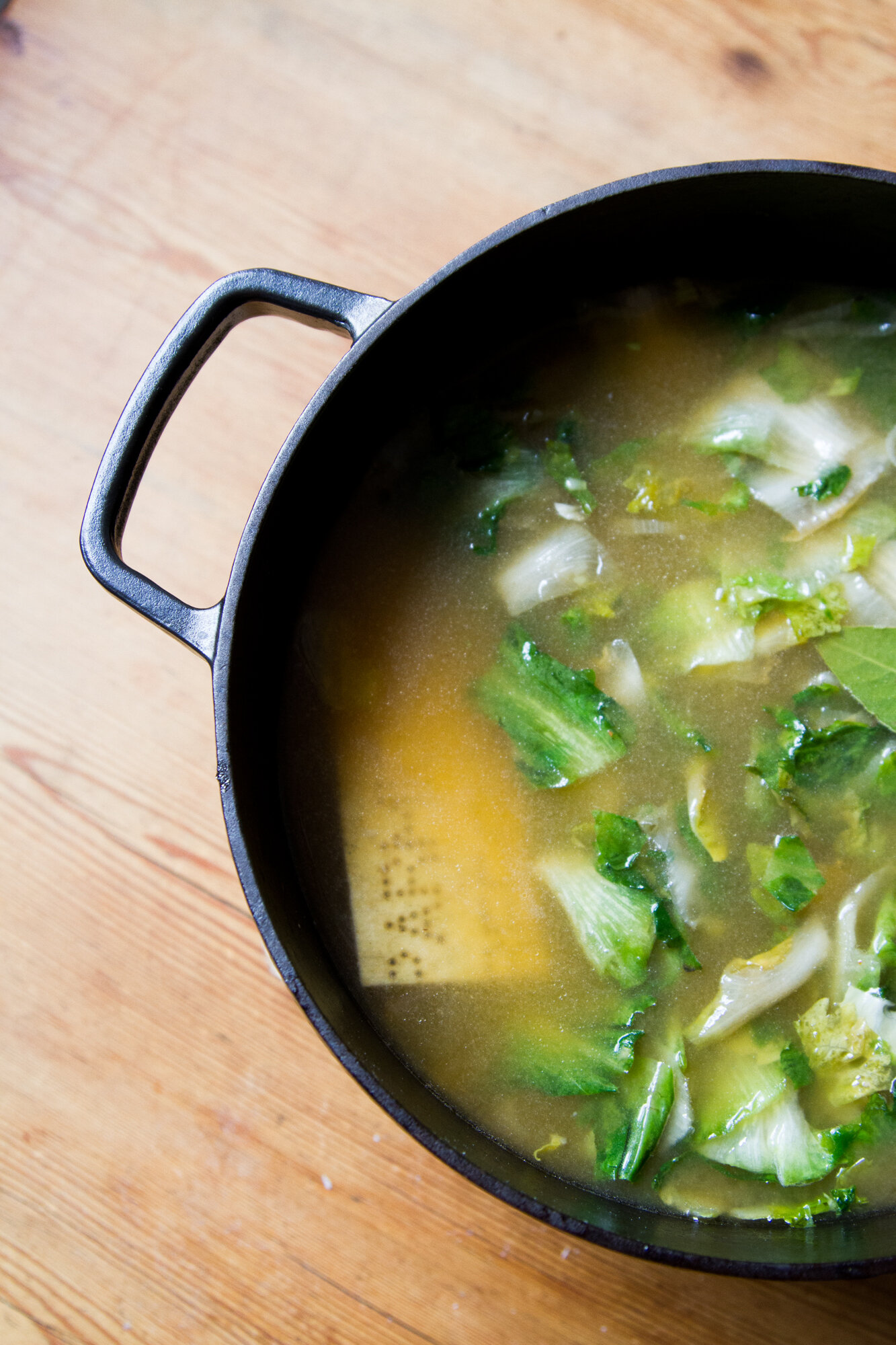
Cannelini & Escarole Soup
Servings- Large: 4 Smaller: 6
Olive oil
3 large garlic cloves, smashed
1 large-ish shallot, thinly sliced
1 large head escarole, chopped and very well rinsed to remove grit/sand
Salt/pepper
Chili flakes
2 (15 oz) cans cannellini beans
1 quart low sodium veg stock (homemade or high-quality store bought)
2 fresh bay leaves (3 dried)
2 oz Parm rind(s)
½ lb ditalini or baby shells
Grated Parm
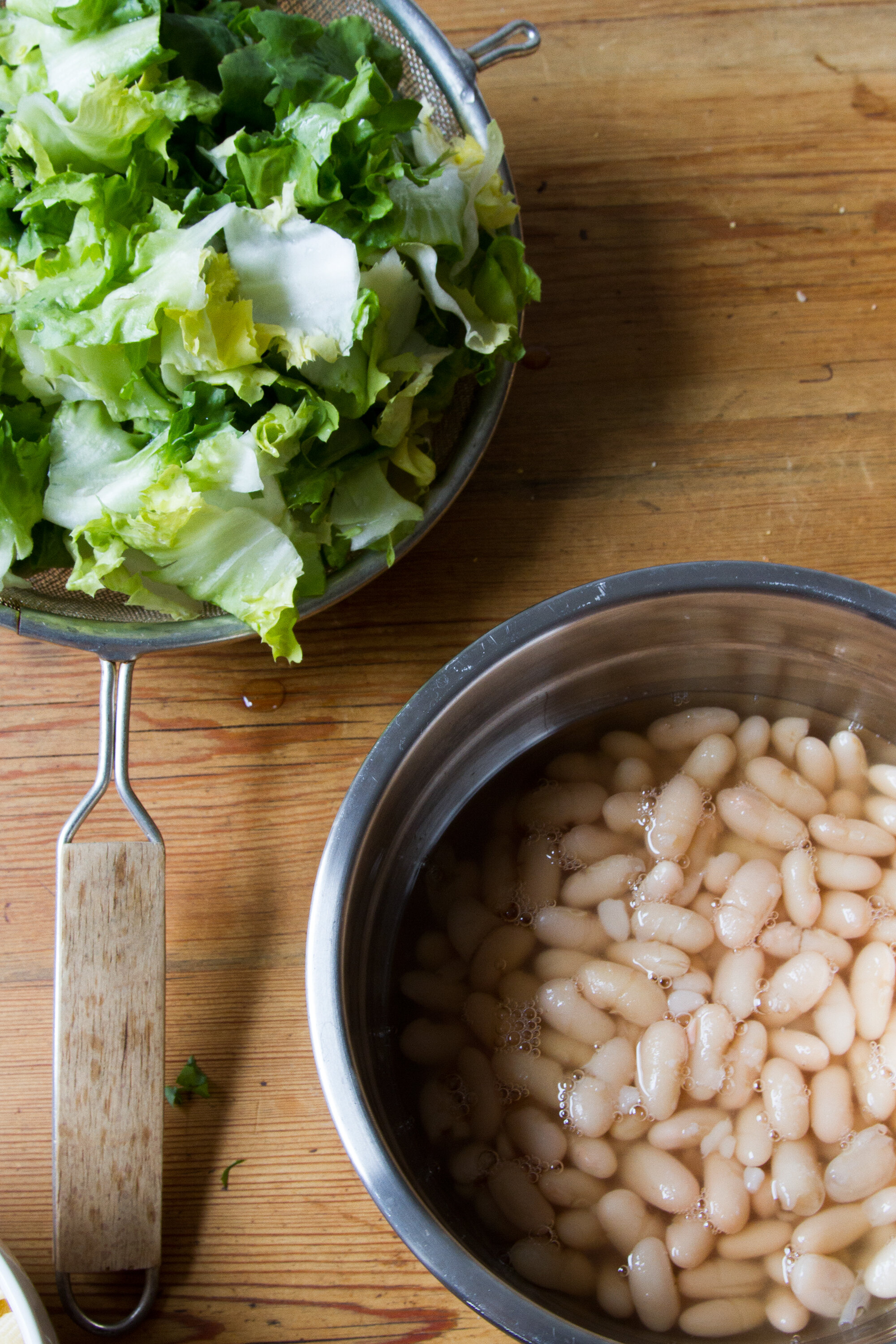 Heat 3 tablespoons olive oil in a large pot or Dutch oven over medium-high.
Heat 3 tablespoons olive oil in a large pot or Dutch oven over medium-high.
Add smashed garlic cloves and sliced shallot to pot, cook until lightly golden, 3-4 minutes.
Add the clean escarole by grabbing it with your hands or a spider from the water, leaving the sand/grit behind. Season with ½ Tbsp kosher salt and a few grinds pepper. Add a pinch of chili flakes (or you could leave this out if you’re not down with the heat).
Stir to wilt, 3-4 minutes.
As the escarole cooks, open both cans of beans: drain and rinse 1, pour the second can into a shallow bowl and use the back of a fork to roughly smash the beans and their liquid. Doesn’t have to be totally smooth. Add the smashed beans and their liquid to the pot with the escarole, along with 1 quart each low sodium veggie stock and water, 2 fresh bay leaves, parm rind(s), and 1 tsp salt. Stir to combine.
Bring to a boil, then reduce heat, partially cover and simmer for 20-25 minutes.
Add reserved drained beans and pasta. Cook until pasta is al dente (according to package instructions), stirring occasionally to prevent sticking.
Once done, taste, season with more salt and pepper if necessary (remember you’re going to add grated Parm which brings some salt, too). When you’re ready to serve (which should be kind of prontissimo after it’s done) hit it with some freshly grated Parm, a drizzle of olive oil, and, if you’re like me, more chili flakes.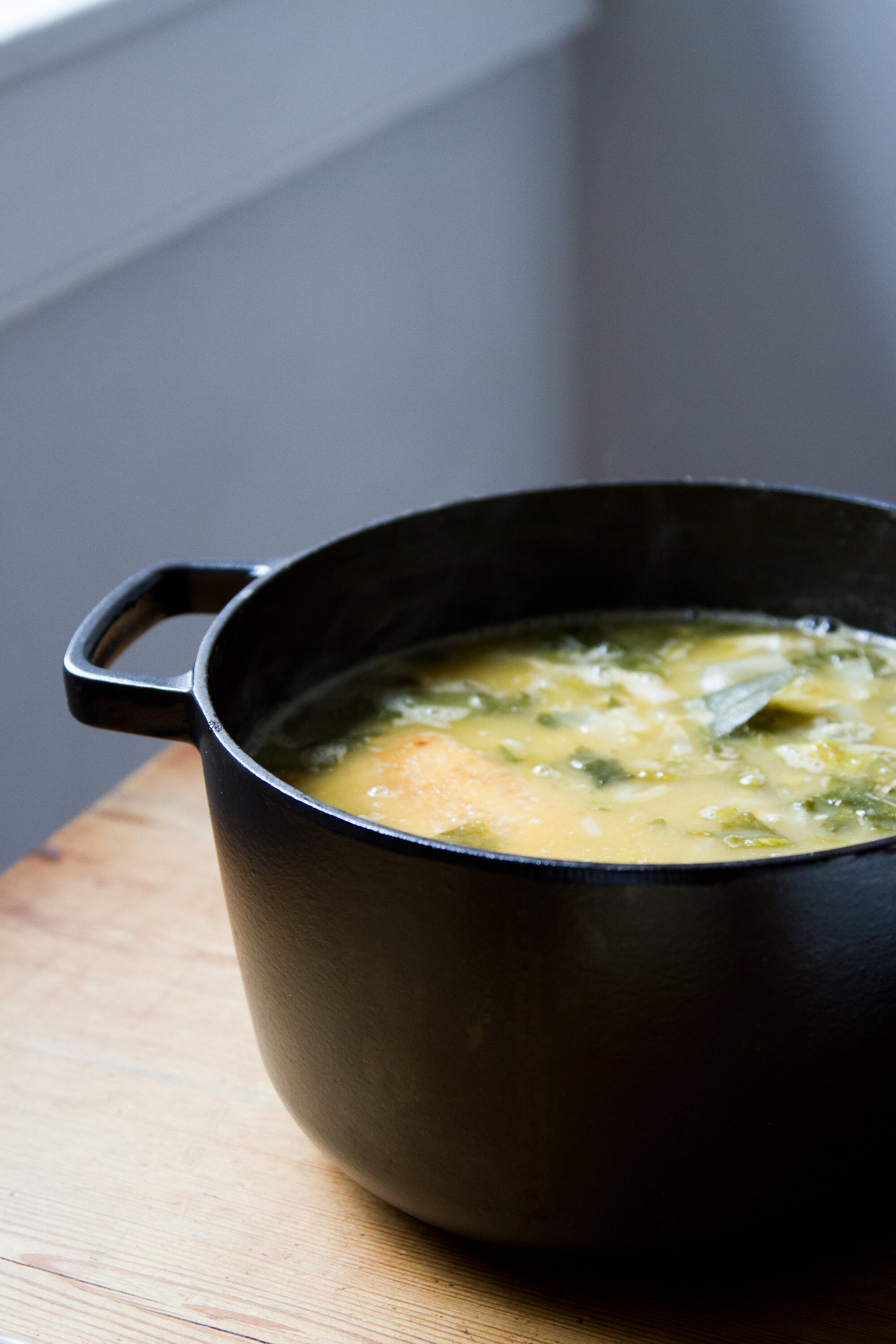
// NOTES:
+ This is just one of lotsa ways I use Parm rinds. And, I make many versions of this soup, usually depending on what kinds of odds and ends I find in my pantry. (Full disclosure: unlike my bud, Erin, I eat meat. Non-meat eaters, ignore this next meat-related tip!) Sometimes, when the food waste gods will it, I find that I have an odd end of bacon or pancetta or a few random leftover bacon strips tucked in the depths of my fridge. It’s dreamy—akin to finding the exact change you need in your pocket. On these occasions, I dice up the pork and start the soup by rendering the fat out and crisping it up. Then I fish out the crispy bits, leaving the fat behind in the pot, and build the soup on the back of that rather than olive oil. Then, I top the bowls with crispy, rendered bacon or pancetta bits when serving.
+ Pasta purists will hate this, but as long as the pasta shapes are around the same size, ie all small, like ditalini and baby shells, or super small, like stellette or pastina, I just combine them in the pot. Voila! 2 (or maybe even 3!) food waste birds killed with 1 stone.
+ I tend to use canned cannellini beans (say that three times fast) because they are speedy and also I like the milky texture that I find hard to replicate when I make them from fresh. Feel free to sub a few cups of beans that you’ve cooked from dried if you’d prefer!
+ If you’d like to make the soup ahead of time, skip adding the pasta initially. Bring the soup back to a boil and add pasta ten minutes before serving.
What about you guys? Do you save your parm rinds? What’s your favorite way to put them to use?
Thanks to Carrie King for writing this post and developing the recipe. When Carrie’s not encouraging me in tiny-apartment cooking adventures, she’s a food writer and editor. Her cookbook work includes Breakfast, Lunch, Dinner….Life with Missy Robbins and The Chef Next Door with Amanda Freitag. She has contributed to Gather Journal and Life & Thyme and works as recipe editor at Marley Spoon and Dinnerly. Thanks to culinary school and lots of time spent in kitchens, both professional and home, she can cook just about anything, but usually just wants a few couple few slices of pizza.



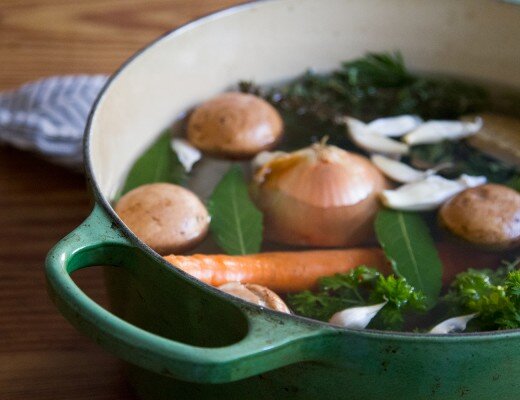
31 Comments
This looks so good! Making and love this theme of no waste foods. I hope to see lots of posts of this. (series ☺)
What a great series! The soup reminds me of something a la Tamar Adler. And loved that Missy Robbins book, I have it on my shelf. Excited to see the next installment in this series. Bravo!
Yum; LOVE escarole soups and this looks delicious. Can’t wait to try! Could I mix in some pecorino rinds, too?
For sure!
Yaaassss! Great thinking! Pecorino rinds can be treated the same as Parm rinds! Which is to say…like gold. 🙂
Yum! This looks awesome. I know this kinda gets rid of the whole no waste idea of the soup but could this be just as tasty without the cheese? I have a dairy allergy but this looks bomb. Love the series idea!
Hey Gill: I’m sure it would still be delicious (maybe just not in the same way!)!
Erin’s right- you could definitely still do this without the cheese. To make up for it in the flavor department, you could drop a sprig or two of another herb, like rosemary. (And, dare I say it, if you’re a meat eater, you could crisp up some pancetta or bacon as a flavor base.)
Hi Erin and Carrie! I’m a huge fan of this new series – and this recipe looks delicious – but it’s a little misleading to call this vegetarian.
Perhaps things are different states side, but in Europe to be called Parmigiano Reggiano, parmesan has to be made in Italy to traditional methods, and that means using calf rennet.
I’m sure most vegetarian readers will be aware of this, but worth mentioning. Sadly many restaurants still mark dishes as vegetarian despite containing non-vegetarian rennet.
Hey Sarah: I consider myself a vegetarian but I do eat cheeses made with rennet. Very easy to omit if you’d rather not!
Hi Sarah! I’m a cheesemonger in the states and make sure that vegetarian customers are informed about different rennet options when they make their purchases, and interestingly enough I’ve found that once I explain how traditional rennet is created, the vegetarians I speak to are quite divided on the issue! Since it’s an extracted enzyme, not actually a meat product, people often decide they’re fine with it. I suspect it’s much the same as the issue vegans run into with alcohol that is filtered with shells or isinglass.
But I thought parmesan isn’t vegetarian due to being made with rennet? I know the author says she eats meat, but the intro says it’s a vegetarian recipe 🙂
Can you get vegetarian versions?? (That would be great news)
Hey Genevieve: Erin here! I consider myself a vegetarian, but I do eat cheeses made with rennet. (You can see Carrie’s note in the comment above about making this recipe without dairy!)
Ah okay, I think if vegetarian for sustainability reasons then it’s logical to be flexible on that sort of thing. Thanks for the recipe! I recently moved to a flat without a freezer so am finding not wasting food to be a challenge, look forward to the rest of the posts! (On the plus side though we now have curbside weekly compost collection which is so good!)
A wonderful post which I hope develops into a series. I love simple meals which use what I have on hand and cut down on waste. This soup looks lovely!
I’ve been using and saving parm rinds since learning to cook in my mother’s kitchen 50 years ago. Only recently though, I discovered the most wonderful broth made using them over at the Smitten Kitchen website. The recipe uses only onions, parm rinds and minimal herbs ending in the most fabulous comforting broth ever.
Thanks for the recipe and I love the idea of this series! With a pressure cooker, you can cook beans from scratch and have them turn out as soft as canned, but more flavorful (and it’s super speedy). I also always add onion, garlic, bay, kombu, parsley and a little olive oil when I cook beans, so I end up with a nice stock too.
This sounds so delicious! My husband is vegetarian and love soup so this sounds like a winner for sure! Thank you so much for the inspiration (and I promise to never compost my parm rinds again)
Any suggestions with what escarole could be replaced? Thank you.
Hi Anna! Red kale or Swiss chard would work well, too. And I often sub them based on what’s looking best at the market!
For any vegetarians concerned about traditional animal rennet, keep an eye out for a cheese called Gran Kinara. It looks just like parm or grana padano, tastes extremely similar (I can only taste the difference when doing a side-by-side comparison), same texture and rind, and is made with thistle rennet!
I recently made my first soup using a parm rind, so I’m glad to see this recipe! One question: if there is still a big hunk of rind left in the pot when the soup is done cooking, what should you do with it? Can you break it up into smaller pieces and leave it in, or blend it with some stock using an immersion blender? Or if I let the soup cook longer will it eventually all melt? Thanks for the help!
My husband likes to eat it! I don’t like the texture, though. I discard it when the pot is empty.
This recipe looks fun and delicious, especially understanding that it can be made dairy free, though I do miss your voice, Erin!
Not to worry! Not going anywhere! (And so glad to welcome the voice of a dear friend!)
My husband calls them soup bones! Our local pasta shop/deli gives them away. Can’t wait to make this!
Hey Erin, I enjoy your blog greatly but find myself increasingly disturbed by your non-exploration of the terrible violence–ecological as well as to farmed animals–of dairy. There are beautiful vegan cheeses today, and you wouldn’t even need to think of waste from a sustainability point of view because the true waste of dairy cheeses is the carbon footprint, and that reduces to a fraction for plant-based cheeses, whatever those are. Would you consider broadening the discourse of sustainability around dairy please? Your blog is gentle, inspiring and kind, unfailingly beautiful and thoughtful, but I’m finding myself increasingly alienated by this blindspot, so thought I would bring it up for discussion. Thanks!
Hi Aneeta, This is an evolving journey for me. I’ve shared a number of nut milk recipes over the past two years as I continue to test my comfort level, try new things, and strive toward making sustainable choices for me and my family. I don’t envision a future of veganism for myself, but I’m certainly mindful of the impact of animal agriculture and very thoughtful about how I procure dairy (as well as eggs, which I also eat), and how regularly we integrate it into our meals. I hope you can afford me the same patience and understanding that I’m currently attempting with myself.
I’m a little late to last week’s dinner party, but wanted to raise my hand to say that we made this for dinner on one of what has been a string of raw, rainy evenings. I know I was saving those parmesan rinds for a good cause! I just finished the last of it for lunch today. So good. I only wish that I’d used a bit more escarole. Next time!
i like escarole soup most of all, the white bean sound like something to try out too!
What a great read. I have the tiniest bag of parm rinds in the freezer now. Looking forward to trying them out in this soup recipe once I get another one.
Comments are moderated.